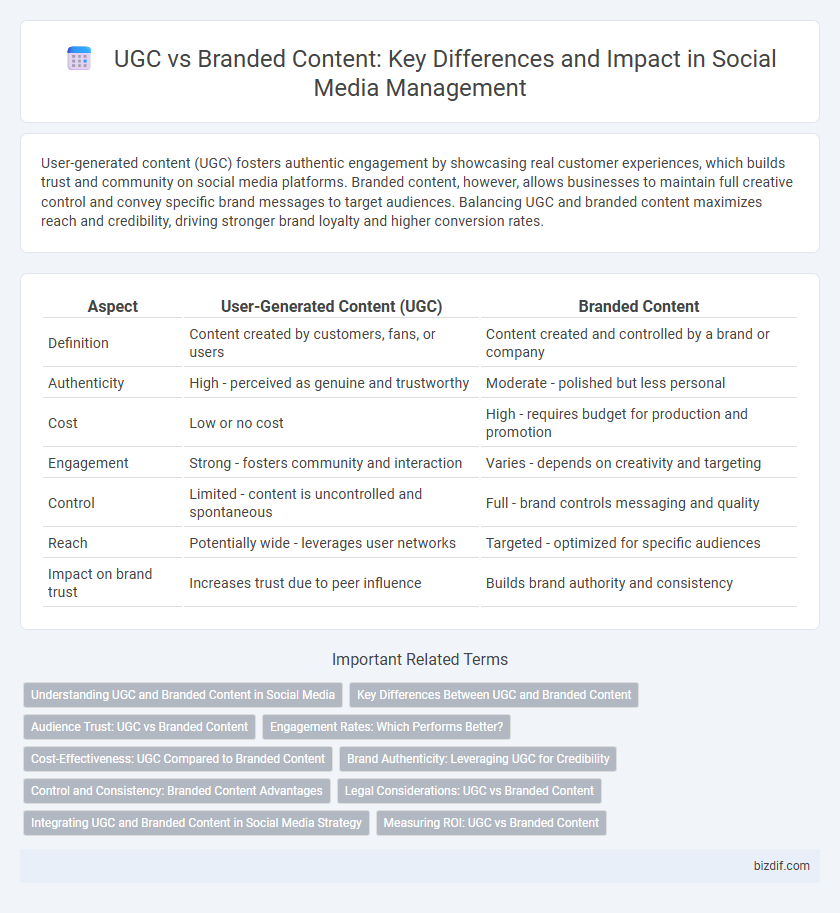User-generated content (UGC) fosters authentic engagement by showcasing real customer experiences, which builds trust and community on social media platforms. Branded content, however, allows businesses to maintain full creative control and convey specific brand messages to target audiences. Balancing UGC and branded content maximizes reach and credibility, driving stronger brand loyalty and higher conversion rates.
Table of Comparison
| Aspect | User-Generated Content (UGC) | Branded Content |
|---|---|---|
| Definition | Content created by customers, fans, or users | Content created and controlled by a brand or company |
| Authenticity | High - perceived as genuine and trustworthy | Moderate - polished but less personal |
| Cost | Low or no cost | High - requires budget for production and promotion |
| Engagement | Strong - fosters community and interaction | Varies - depends on creativity and targeting |
| Control | Limited - content is uncontrolled and spontaneous | Full - brand controls messaging and quality |
| Reach | Potentially wide - leverages user networks | Targeted - optimized for specific audiences |
| Impact on brand trust | Increases trust due to peer influence | Builds brand authority and consistency |
Understanding UGC and Branded Content in Social Media
User-generated content (UGC) in social media involves authentic posts created by consumers, reflecting genuine experiences and fostering trust through organic engagement. Branded content, crafted by companies, strategically promotes brand identity and messaging with controlled narratives and design elements. An effective social media strategy balances UGC's credibility with branded content's targeted communication to maximize audience connection and brand loyalty.
Key Differences Between UGC and Branded Content
User-generated content (UGC) originates directly from consumers, reflecting authentic experiences and organic engagement, while branded content is strategically created by brands to promote products or services with controlled messaging. UGC typically drives higher trust and social proof due to its perceived authenticity, whereas branded content ensures consistency in brand voice and visual identity. Metrics show UGC can increase conversion rates by up to 4x compared to branded content, highlighting its impact on consumer decision-making.
Audience Trust: UGC vs Branded Content
User-generated content (UGC) fosters higher audience trust due to its authentic and relatable nature, often perceived as unbiased opinions from real users. Branded content, while carefully crafted to align with marketing goals, may struggle to gain the same level of credibility because audiences recognize it as promotional material. Studies show that over 70% of consumers trust UGC more than traditional advertising, making it a powerful tool for driving engagement and brand loyalty.
Engagement Rates: Which Performs Better?
User-generated content (UGC) typically achieves higher engagement rates compared to branded content, as audiences find authentic and relatable posts more trustworthy. Studies indicate UGC can boost engagement by up to 28% due to its perceived authenticity and community-driven appeal. Brands leveraging UGC in their social media strategies often see increased likes, shares, and comments, fostering stronger customer connections and loyalty.
Cost-Effectiveness: UGC Compared to Branded Content
User-generated content (UGC) offers a significantly more cost-effective solution compared to branded content due to lower production expenses and organic reach potential. UGC leverages authentic customer experiences and reduces the need for extensive creative teams or expensive advertising budgets. Brands investing in UGC see higher engagement rates and improved return on investment while minimizing upfront costs.
Brand Authenticity: Leveraging UGC for Credibility
User-generated content (UGC) enhances brand authenticity by offering genuine customer experiences that resonate more deeply than traditional branded content. UGC serves as social proof, increasing credibility through real-life endorsements and fostering trust among potential consumers. Brands leveraging UGC benefit from organic engagement and stronger emotional connections, positioning themselves as authentic and relatable in competitive social media landscapes.
Control and Consistency: Branded Content Advantages
Branded content offers superior control over messaging, visuals, and overall brand identity, ensuring consistent communication across all social media platforms. Unlike UGC, which can vary in tone and quality, branded content allows precise alignment with strategic marketing goals and brand guidelines. This consistency enhances brand recognition and fosters stronger audience trust by delivering a uniform experience at every customer touchpoint.
Legal Considerations: UGC vs Branded Content
User-generated content (UGC) requires careful legal consideration, including obtaining explicit permissions from content creators to avoid copyright infringements and ensuring compliance with privacy laws. Branded content, produced or commissioned by the brand, typically involves clear ownership rights and adherence to advertising regulations such as FTC disclosure requirements for sponsored posts. Navigating intellectual property rights and consent protocols is essential for both UGC and branded content to mitigate legal risks in social media management.
Integrating UGC and Branded Content in Social Media Strategy
Integrating UGC (user-generated content) with branded content in social media strategy enhances authenticity and drives engagement by leveraging real customer experiences alongside professional brand messaging. Brands that strategically combine UGC with branded visuals and copy witness higher trust levels, increased reach, and better conversion rates across platforms like Instagram, TikTok, and Facebook. Optimizing this blend through analytics tools can refine content targeting, ensuring relevance and maximizing campaign ROI.
Measuring ROI: UGC vs Branded Content
Measuring ROI for UGC versus branded content involves analyzing engagement metrics, conversion rates, and cost efficiency, with UGC often showing higher authenticity and trust, leading to improved customer acquisition and retention. Branded content allows for precise targeting and consistent messaging but can incur higher production costs and lower spontaneous engagement. Leveraging analytics tools to compare performance data across platforms helps optimize marketing spend by focusing on content that drives the best return, whether through organic reach or paid promotions.
UGC (user-generated content) vs branded content Infographic

 bizdif.com
bizdif.com